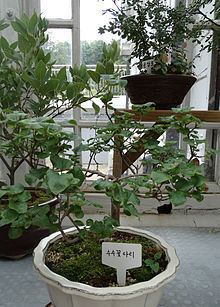Rank Subspecies | ||
 | ||
Similar Syringa oblata, Syringa tomentella, Syringa × laciniata, Syringa komarowii, Syringa pubescens | ||
Syringa oblata subsp. dilatata, also known as Korean early lilac, is a subspecies of the species Syringa oblata in the genus Syringa, in the family Oleaceae.
Contents
Description
Habitat
Gravelly mountains, 100-700m altitude.
Distribution
China: Jilin and Liaoning provinces.
Korea: Throughout.
Cultivation
Widely cultivated. Notable cultivars include:
Etymology
Oblata from the modern Latin oblatus, meaning 'somewhat flattened at the ends, oval, oblate'. Dilatata means 'widened', 'spread out', or 'dilated'. Syringa is derived from the Greek word syrinx, meaning 'pipe' or 'tube'. Named for the use of its hollow stems to make flutes. In Greek mythology, the nymph Syringa was changed into a reed.
References
Syringa oblata subsp. dilatata Wikipedia(Text) CC BY-SA
